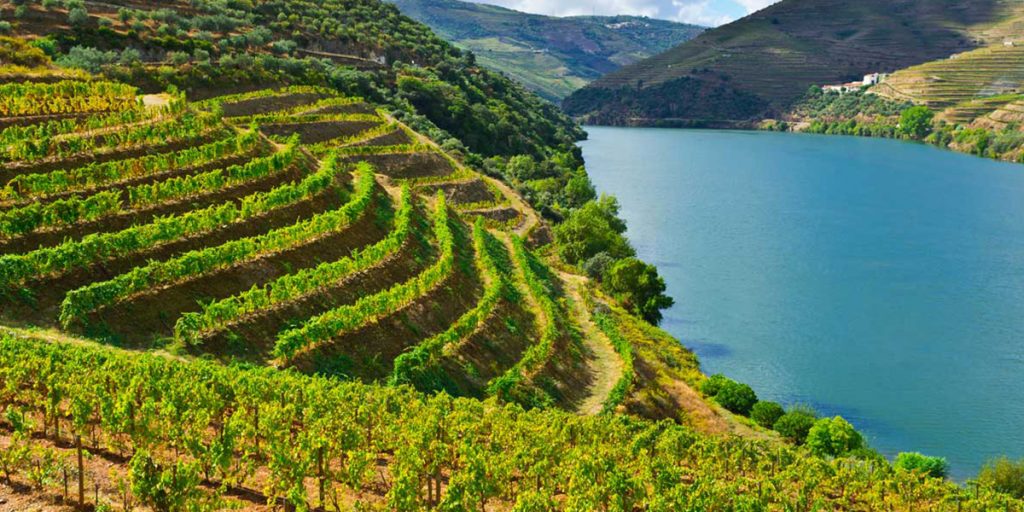Signature Croatia Discovery Tour
per person
10 Day Land Tour – Customize this for your perfect Croatia vacation.
Visiting: SPLIT – TROGIR – ŠIBENIK – HVAR – KORČULA – DUBROVNIK
Curious what our other clients have said about Adventures Croatia? Read some of their reviews.
10 Days
1
Day 1: SPLIT
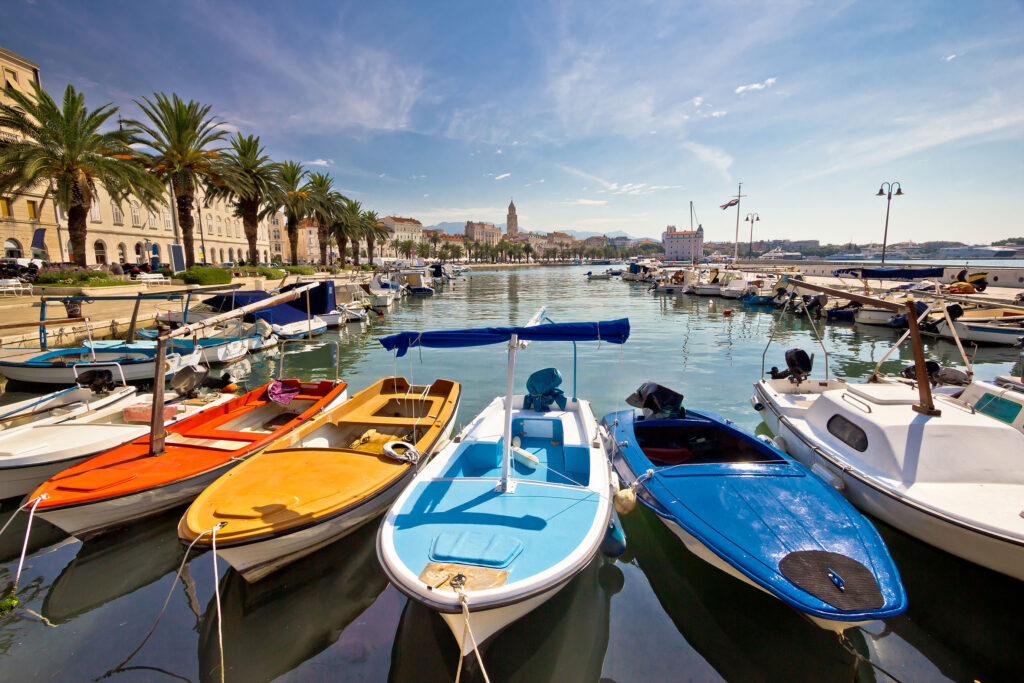 Olives, indigenous aromatic plants, the brilliancy of white stone against the verdant vegetation, and the towering mountain massif of Biokovo whose spurs reach all the way to the sea – yes, this is indeed an exceptional part of the country, and its beauty is made all the more enchanting by numerous historic events and monuments, and cultural manifestations.
When, in the year 305, the Roman Emperor Diocletian, who ruled the entire world at that time, decided to build his leisure time abode - in which he intended to spend the rest of his life - he had no doubt as to exactly where build to it. In the very heart of Dalmatia, in the bay of Aspalathos (Split), well protected from the sea by the islands of the Split archipelago, and defended on its landward side by high mountains, Diocletian created a special point on the map of the Adriatic: the future city of Split.
Olives, indigenous aromatic plants, the brilliancy of white stone against the verdant vegetation, and the towering mountain massif of Biokovo whose spurs reach all the way to the sea – yes, this is indeed an exceptional part of the country, and its beauty is made all the more enchanting by numerous historic events and monuments, and cultural manifestations.
When, in the year 305, the Roman Emperor Diocletian, who ruled the entire world at that time, decided to build his leisure time abode - in which he intended to spend the rest of his life - he had no doubt as to exactly where build to it. In the very heart of Dalmatia, in the bay of Aspalathos (Split), well protected from the sea by the islands of the Split archipelago, and defended on its landward side by high mountains, Diocletian created a special point on the map of the Adriatic: the future city of Split.
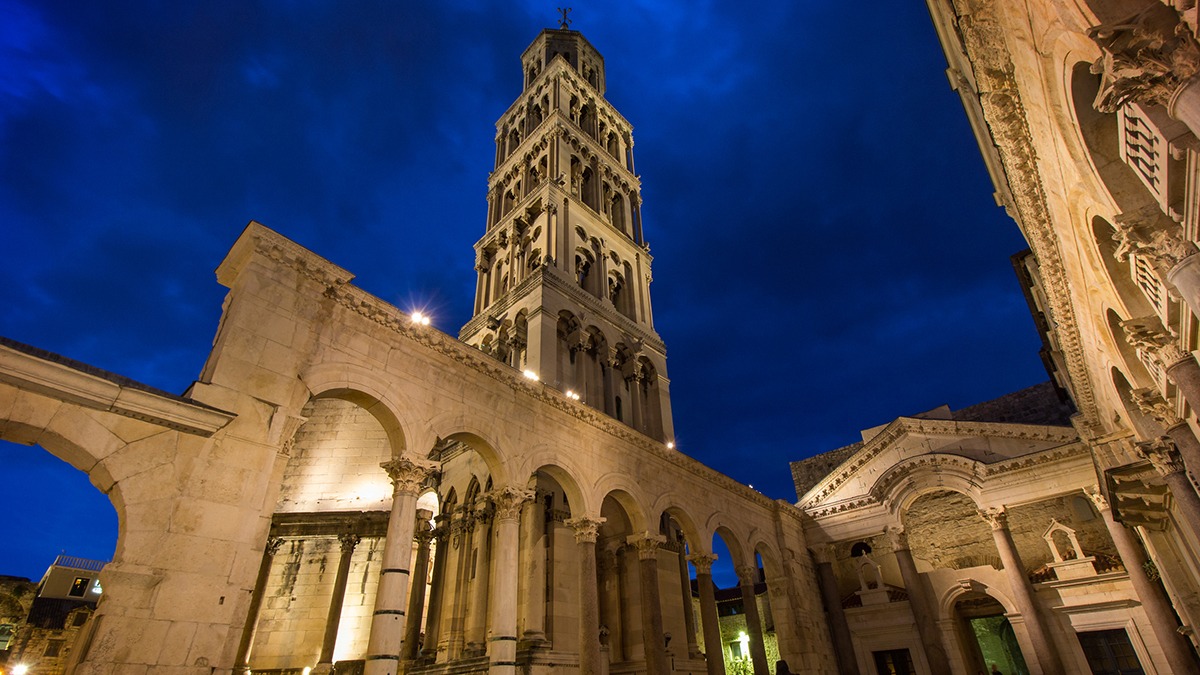 There’s no doubt Diocletian’s Palace is the top must-see attraction in Croatia’s second-biggest city – Split. This UNESCO protected World Heritage Site is actually the heart of the whole city – almost two thousand years old, the enormous palace exists today as a “living monument” – meaning it’s dotted with quaint shops, galleries, cafes, restaurants, and people actually live and work within its old walls. And that’s what makes it really special – it’s an ancient Roman palace absolutely integrated into the everyday life and doings of Split and its people.
There’s no doubt Diocletian’s Palace is the top must-see attraction in Croatia’s second-biggest city – Split. This UNESCO protected World Heritage Site is actually the heart of the whole city – almost two thousand years old, the enormous palace exists today as a “living monument” – meaning it’s dotted with quaint shops, galleries, cafes, restaurants, and people actually live and work within its old walls. And that’s what makes it really special – it’s an ancient Roman palace absolutely integrated into the everyday life and doings of Split and its people.
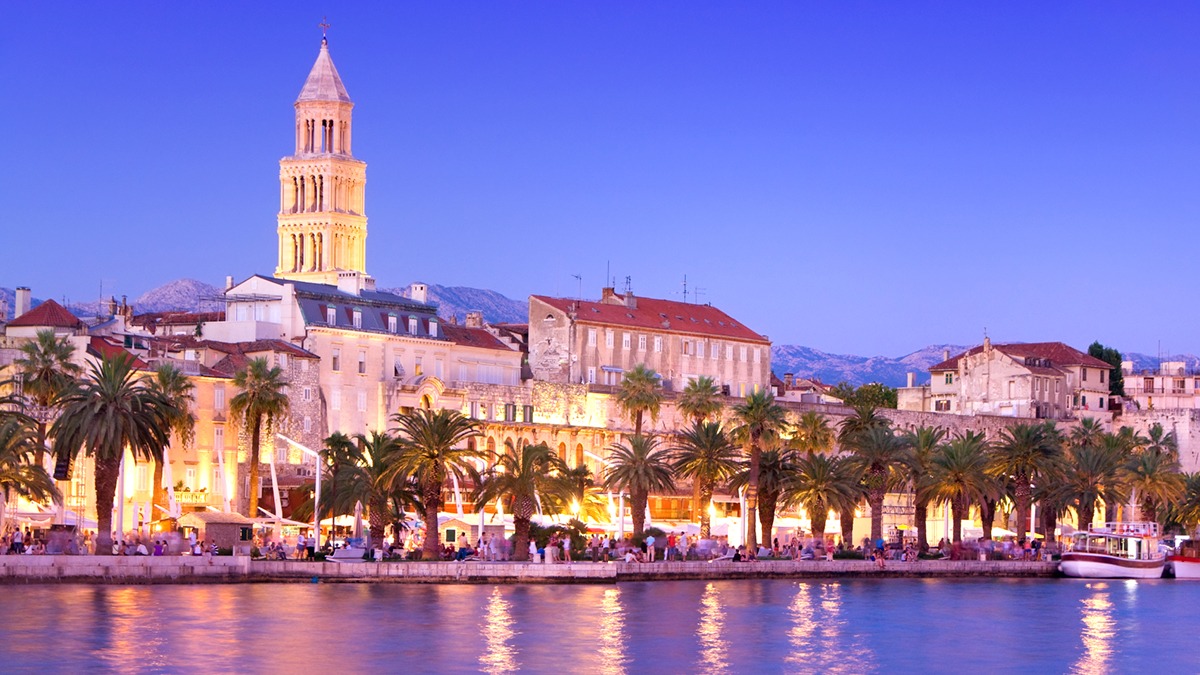 The Riva, a marble-white and palm-lined connection of Split and the Adriatic is everyone’s favorite spot for socializing, coffee-drinking or just idle sitting on one of the comfy benches which face the sea. Riva is full of life throughout the day, especially during the summer, and you’ll always find people strolling along or sitting in one of the cafes. So, if you want to get a feeling of the local everyday “buzz” be sure to grab your spot and you’ll soon experience first-hand how important and irresistible is the coffee culture in Croatia.
And finally, maybe not the most important but certainly the yummiest must-do activity of all – food! ;) Split, especially its Old Town, is literally dotted with colorful food stalls, konoba (a type of traditional Dalmatian tavern), and quaint little restaurants. Don’t miss local delicacies, such as fish prepared na gradele and pašticada. Street food culture in Split is also pretty strong and you can never go hungry since there’s always some inviting bite-sized treat waiting for you around the corner.
What to do in Split
Split is more than just a gateway to the islands. Discover the best things to do in Split, from lazing on Bačvice beach to sightseeing.
There are plenty of things to do in Split now that – thankfully – its days as a departure point to the nearby islands are gone. Brimming with recently opened high-quality bistros, antiquities aplenty and the best bar scene on the Adriatic coast, Croatia’s main ferry port is also the country’s most promising all-round city-break destination.
Barhop around the Palace
The Diocletian’s Palace is the perfect backdrop for Croatia’s best bar crawl, a night of revelry in the secret alleyways and hidden corners of this atmospheric ruin overlooking the seafront. Certain bars stand out amid the blur – though whether you’ll be able to find them the next night is another matter. In fact, retracting your footsteps, or trying to, is half the fun. In any case, do look out for Charlie's Bar, To je to, Figa, Gaga, and the long-established Academia Ghetto Club. If you just want to sit down for ten minutes and observe, then the little hub on Majstora Jurja containing Teak and Na Kantunu should do nicely.
Gawk at an Adriatic sunset
Split’s focal embankment officially titled Obala Hrvatskog Narodnog Preporoda, the Riva is where the city meets over coffee. As the sun moves across the sky, and thoughts turn to the night ahead, customers on the dozen or so café terraces tend to start ordering stiff drinks rather than coffee. This is just the time to sneak into the Diocletian’s Palace behind, follow the yellow arrows near the Hotel Vestibule Palace, and find yourself at a bar called, in fact, Dioklecijan. Although somewhat basic in appearance, its advantage is equally simple: a scattering of bar tables set outside, immediately above the Riva. Find one by the three Roman-era arches (hence its local nickname, ‘Tri Volta’), and you get a perfect view of the sun setting over the Adriatic. Order up a cold drink, maybe a signature doorstep sandwich of prosciutto and cheese, and take in the last of the day’s rays.
Itinerary:
The Riva, a marble-white and palm-lined connection of Split and the Adriatic is everyone’s favorite spot for socializing, coffee-drinking or just idle sitting on one of the comfy benches which face the sea. Riva is full of life throughout the day, especially during the summer, and you’ll always find people strolling along or sitting in one of the cafes. So, if you want to get a feeling of the local everyday “buzz” be sure to grab your spot and you’ll soon experience first-hand how important and irresistible is the coffee culture in Croatia.
And finally, maybe not the most important but certainly the yummiest must-do activity of all – food! ;) Split, especially its Old Town, is literally dotted with colorful food stalls, konoba (a type of traditional Dalmatian tavern), and quaint little restaurants. Don’t miss local delicacies, such as fish prepared na gradele and pašticada. Street food culture in Split is also pretty strong and you can never go hungry since there’s always some inviting bite-sized treat waiting for you around the corner.
What to do in Split
Split is more than just a gateway to the islands. Discover the best things to do in Split, from lazing on Bačvice beach to sightseeing.
There are plenty of things to do in Split now that – thankfully – its days as a departure point to the nearby islands are gone. Brimming with recently opened high-quality bistros, antiquities aplenty and the best bar scene on the Adriatic coast, Croatia’s main ferry port is also the country’s most promising all-round city-break destination.
Barhop around the Palace
The Diocletian’s Palace is the perfect backdrop for Croatia’s best bar crawl, a night of revelry in the secret alleyways and hidden corners of this atmospheric ruin overlooking the seafront. Certain bars stand out amid the blur – though whether you’ll be able to find them the next night is another matter. In fact, retracting your footsteps, or trying to, is half the fun. In any case, do look out for Charlie's Bar, To je to, Figa, Gaga, and the long-established Academia Ghetto Club. If you just want to sit down for ten minutes and observe, then the little hub on Majstora Jurja containing Teak and Na Kantunu should do nicely.
Gawk at an Adriatic sunset
Split’s focal embankment officially titled Obala Hrvatskog Narodnog Preporoda, the Riva is where the city meets over coffee. As the sun moves across the sky, and thoughts turn to the night ahead, customers on the dozen or so café terraces tend to start ordering stiff drinks rather than coffee. This is just the time to sneak into the Diocletian’s Palace behind, follow the yellow arrows near the Hotel Vestibule Palace, and find yourself at a bar called, in fact, Dioklecijan. Although somewhat basic in appearance, its advantage is equally simple: a scattering of bar tables set outside, immediately above the Riva. Find one by the three Roman-era arches (hence its local nickname, ‘Tri Volta’), and you get a perfect view of the sun setting over the Adriatic. Order up a cold drink, maybe a signature doorstep sandwich of prosciutto and cheese, and take in the last of the day’s rays.
Itinerary:
- Arrive at Split Airport and meet with your driver for a private transfer to your hotel.
- Check into your hotel, relax and explore the hotel facilities.
- Time at leisure to explore the city on your own, enjoy a drink or dinner in one of the many restaurants (on your own)
- Time at leisure and an overnight in Split
2
Day 2: SPLIT - TROGIR - SPLIT
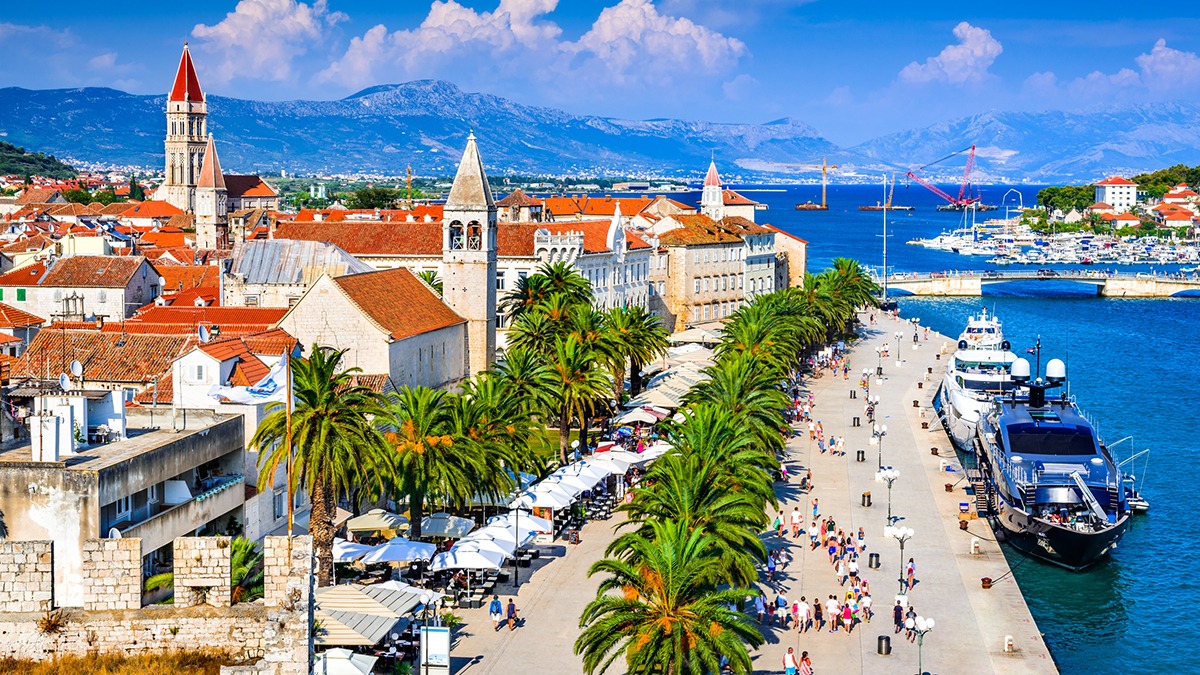 Trogir, a harmonious stone town on a small island that is connected to the mainland and the island of Čiovo by bridges. The old town, under UNESCO protection, is a treasure trove for lovers of art, Renaissance and Baroque buildings, Romanesque churches...
It is called the town-museum which is visible in the famous portal of Trogir cathedral by the craftsman Radovan in 1240, a Renaissance city lodge, the thousand-year-old Monastery of Sv. Nikola [St. Nicholas] which has the ancient famous relief of Kairos preserved in it from the 4th century BC.
Cathedral of St. Lawrence - During structural repairs to the foundations of the bell tower in 1903, an altar consecrated to Hera was found, which might well warrant the assumption that there was once, on the site of today's cathedral, a shrine from at least the Greek and Roman period. The new foundations of St Lawrence's Cathedral were blessed at the beginning of the 13th century after the old cathedral had been ruined in the Venetian destruction of the city in 1171.
Radovan's portal - A genuine trademark of Trogir sculpting is Master Radovan, the most important sculptor of Croatian medieval art. He signed his name on the main portal in an inscription that runs under the lunette and reliefs of the Annunciation at the side, where he is celebrated as “the best of all in this art” (cunctis hac arte preclarum). In the center of the upper zone of the portal is a lunette in which Radovan managed to link into a united composition the scenes of Nativity, the Journey of the Magi, and the Adoration of the Shepherds.
The main city square - The program of designing the appearance of the main city square in Trogir, at the site of the Roman forum, started in 1300 with the construction of the commune's loggia and the council chamber. The square acquired its final shape in a number of operations in the mid-15th century, at a time when the city really was renovated.
The large Cipiko palace - Father and son, Petar and Koriolan Cipiko, managed, clearly according to a certain family program and with strategic marriages, to occupy the whole western side of the main square with their two palaces – opposite the council chamber, the cathedral and the other public buildings.
The southern portal, with medallions of angels bearing Koriolan's motto Nosce te Ipsum (Know thyself), is the work of Niccolo, around 1470. The northern portal, opposite the portal of the cathedral, is the work of Ivan Duknović, fitted into the place, however, with Aleši three-mullion windows in the mid 17th century after the palace complex had been divided between two brothers and restored after the devastation by the Venetian militia that used the palaces as a barracks during the Cyprus War.
Itinerary:
Trogir, a harmonious stone town on a small island that is connected to the mainland and the island of Čiovo by bridges. The old town, under UNESCO protection, is a treasure trove for lovers of art, Renaissance and Baroque buildings, Romanesque churches...
It is called the town-museum which is visible in the famous portal of Trogir cathedral by the craftsman Radovan in 1240, a Renaissance city lodge, the thousand-year-old Monastery of Sv. Nikola [St. Nicholas] which has the ancient famous relief of Kairos preserved in it from the 4th century BC.
Cathedral of St. Lawrence - During structural repairs to the foundations of the bell tower in 1903, an altar consecrated to Hera was found, which might well warrant the assumption that there was once, on the site of today's cathedral, a shrine from at least the Greek and Roman period. The new foundations of St Lawrence's Cathedral were blessed at the beginning of the 13th century after the old cathedral had been ruined in the Venetian destruction of the city in 1171.
Radovan's portal - A genuine trademark of Trogir sculpting is Master Radovan, the most important sculptor of Croatian medieval art. He signed his name on the main portal in an inscription that runs under the lunette and reliefs of the Annunciation at the side, where he is celebrated as “the best of all in this art” (cunctis hac arte preclarum). In the center of the upper zone of the portal is a lunette in which Radovan managed to link into a united composition the scenes of Nativity, the Journey of the Magi, and the Adoration of the Shepherds.
The main city square - The program of designing the appearance of the main city square in Trogir, at the site of the Roman forum, started in 1300 with the construction of the commune's loggia and the council chamber. The square acquired its final shape in a number of operations in the mid-15th century, at a time when the city really was renovated.
The large Cipiko palace - Father and son, Petar and Koriolan Cipiko, managed, clearly according to a certain family program and with strategic marriages, to occupy the whole western side of the main square with their two palaces – opposite the council chamber, the cathedral and the other public buildings.
The southern portal, with medallions of angels bearing Koriolan's motto Nosce te Ipsum (Know thyself), is the work of Niccolo, around 1470. The northern portal, opposite the portal of the cathedral, is the work of Ivan Duknović, fitted into the place, however, with Aleši three-mullion windows in the mid 17th century after the palace complex had been divided between two brothers and restored after the devastation by the Venetian militia that used the palaces as a barracks during the Cyprus War.
Itinerary:
- Breakfast at the hotel.
- Meeting with your guide for a private walking tour of Old Town Split.
- This tour of Split will show you places of historical importance and take you to places off the beaten path.
- Meet with your driver for a private transfer to Trogir. Upon arrival, a private walking tour of Old Town Trogir will follow.
- Return to Split for time at leisure to explore the city on your own.
3
Day 3: SPLIT – ŠIBENIK – SPLIT
 A coastal city that has endured nearly a millennium of scorching temperatures, sustaining a few wars, being beaten by the waves, and whipped by relentless winds, Šibenik remains as vibrant as ever. Šibenik consists of stone buildings, stone stairways, rock cliffs, cobbled streets, and stone arches. It is built on rocks and constructed with rocks.
Šibenik is a city of sun, sea, and stone, a unique combination of characteristics that make this a city unlike any other in Croatia.
Additionally, this proud city is the only one on the Croatian coast that was built by Croats—Split and Dubrovnik, for example, were founded by other cultures.
A coastal city that has endured nearly a millennium of scorching temperatures, sustaining a few wars, being beaten by the waves, and whipped by relentless winds, Šibenik remains as vibrant as ever. Šibenik consists of stone buildings, stone stairways, rock cliffs, cobbled streets, and stone arches. It is built on rocks and constructed with rocks.
Šibenik is a city of sun, sea, and stone, a unique combination of characteristics that make this a city unlike any other in Croatia.
Additionally, this proud city is the only one on the Croatian coast that was built by Croats—Split and Dubrovnik, for example, were founded by other cultures.
 Cathedral of St. James - The number one attraction in Šibenik is the Cathedral of St. James. A stunning and stylish building, this magnificent cathedral was built in the 15th and 16th centuries and can be said to be one of the most significant monumental cathedrals in Europe. It wouldn’t be Šibenik if its cathedral weren’t built entirely from stone—in fact, it is the only cathedral in all of Europe that has been constructed with only stone.
Additionally, it was also the very first structure in Europe to be constructed with inter-grooved stones. And that’s not all. The Cathedral of St. James is also the only European building of which the interior shape corresponds entirely with its exterior features. It would by no means be a stretch to state that the Cathedral of St. James can be considered to be the most important Renaissance building in Croatia.
It is truly an absolutely extraordinary building, a vast stone monument, that is one of the top sights on the entire Dalmatian coast. UNESCO recognized the cultural, architectural, and historical significance of this cathedral when it declared it World Heritage in 2000.
Itinerary:
Cathedral of St. James - The number one attraction in Šibenik is the Cathedral of St. James. A stunning and stylish building, this magnificent cathedral was built in the 15th and 16th centuries and can be said to be one of the most significant monumental cathedrals in Europe. It wouldn’t be Šibenik if its cathedral weren’t built entirely from stone—in fact, it is the only cathedral in all of Europe that has been constructed with only stone.
Additionally, it was also the very first structure in Europe to be constructed with inter-grooved stones. And that’s not all. The Cathedral of St. James is also the only European building of which the interior shape corresponds entirely with its exterior features. It would by no means be a stretch to state that the Cathedral of St. James can be considered to be the most important Renaissance building in Croatia.
It is truly an absolutely extraordinary building, a vast stone monument, that is one of the top sights on the entire Dalmatian coast. UNESCO recognized the cultural, architectural, and historical significance of this cathedral when it declared it World Heritage in 2000.
Itinerary:
- Breakfast at the hotel
- Meet your driver for a private transfer from Split to Šibenik where you will enjoy a private walking tour of this ancient time accompanied by your guide.Explore the enchanting narrow streets of Šibenik with a professional local guide who will show you several highlights of the old part of the town, St. James Cathedral is the most famous one. Explore the historic core on foot and enter the magnificent piece of art that is the cathedral in Šibenik. Built in a unique manner, completely out of stone, and abundant with delicate sculptures and ornaments, this fantastic building forms part of the UNESCO and makes every visitor fall in love with it.
- After the walk, enjoy a unique meal experience at a Michelin star awarded restaurant Pelegrini in Šibenik.
- Drive back to Split, time at leisure, and an overnight in Split.
4
Day 4: SPLIT – HVAR
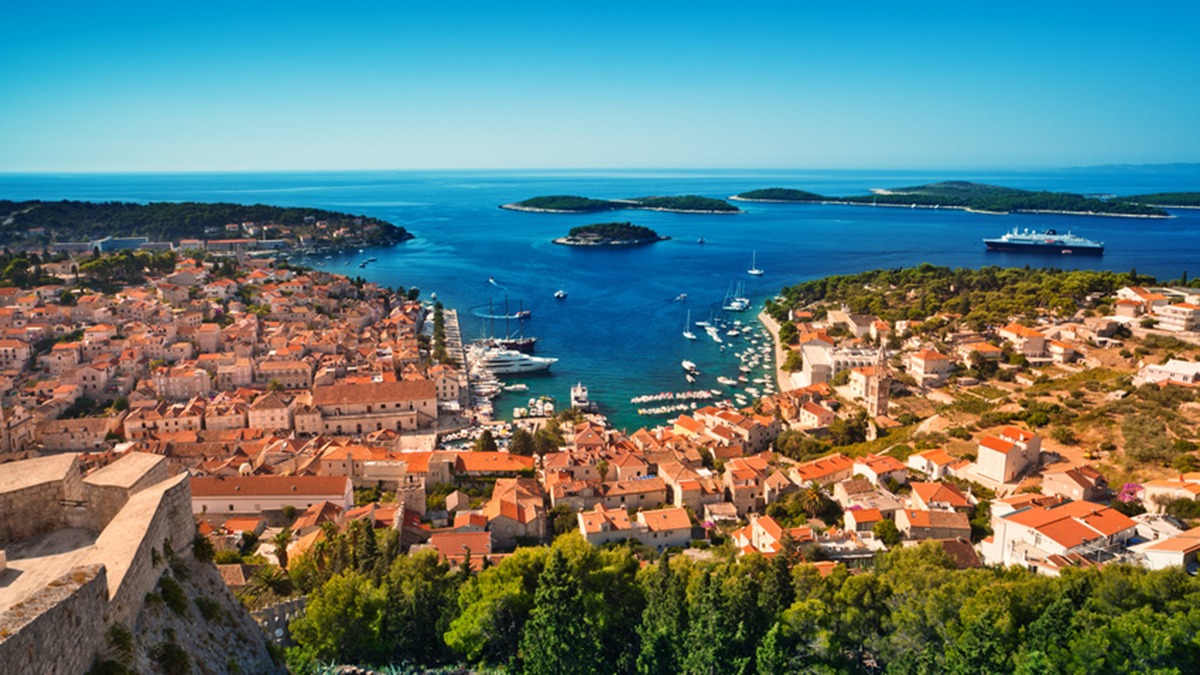 St. Stephen's Square - The center of town is this rectangular square, which was formed by filling in an inlet that once stretched out from the bay. At 4500 sq. meters, it’s one of the largest old squares in Dalmatia. The town first developed in the 13th century to the north of the square and later spread south in the 15th century. Notice the well at the square’s northern end, which was built in 1520 and has a wrought-iron grill dating from 1780.
Cathedral of St Stephen - The cathedral forms a stunning backdrop to the square. The bell tower rises four levels, each more elaborate than the last. The cathedral was built in the 16th and 17th centuries at the height of the Dalmatian Renaissance on the site of a cathedral destroyed by the Turks. Parts of the older cathedral are visible in the nave and in the carved 15thcentury choir stalls.
Fortica - Through the network of tiny streets northwest of St Stephen’s Square, climb up through a park to the citadel built on the site of a medieval castle to defend the town from the Turks. The Venetians strengthened it in 1557 and then the Austrians renovated it in the 19th century by adding barracks. Inside is a tiny collection of ancient amphorae recovered from the seabed. The view over the harbor is magnificent, and there’s a lovely cafe at the top.
Arsenal - On the southern side of St Stephen’s Square, the Arsenal was built in 1611 to replace a building destroyed by the Ottomans. Mentioned in Venetian documents as ‘the most beautiful and the most useful building in the whole of Dalmatia’, the Arsenal once served as a repair and refitting station for war galleons.
The sunniest, the biggest, the oldest. The three most common superlatives used when describing island and town Hvar.
These are some of the highlights: Sv. Stephen’s square or Piazza, The Place where locals meet, living room of Hvar. Theatre in the Arsenal building, after being closed for renovation for over 20 years, this year it finally opened its doors for visitors, audience, and actors. Elegant city Loggia and the old Palace hotel, once Austrian Empress Sissi’s spa hotel, now being renovated into its old glory as Palace Elisabeth heritage hotel, Hvar’s first 5-star hotel! Old streets and Benedictine nunnery, where nuns keep the secret of their unique handicraft which is now a part of UNESCO Cultural Heritage of Humanity - lace-making of agave threads. Renaissance nobility, poets like Hanibal Lucic and Petar Hektorovic left their marks not only in Croatian literature but also in the town’s architecture. Ivan Vucetic, Hvar born father of dactyloscopy, and many more interesting facts. Who would say that Hvar, the “party island” as many like to call it nowadays, has such a rich history.
As the sun sets down, Hvar becomes alive with people; we recommend a cocktail at one of the numerous bars and terraces around the beautifully illuminated harbor.
Experience the best party hotspot of Hvar on one of the nearby terraces. Chill and relax with different aperitifs and smooth jazz music or live bands. Elegant and well-dressed couples, as well as families, stop for a drink as an introduction for a delicious dinner in one of Hvar´s fabulous restaurants or as a start for a long and exciting party night.
Itinerary:
St. Stephen's Square - The center of town is this rectangular square, which was formed by filling in an inlet that once stretched out from the bay. At 4500 sq. meters, it’s one of the largest old squares in Dalmatia. The town first developed in the 13th century to the north of the square and later spread south in the 15th century. Notice the well at the square’s northern end, which was built in 1520 and has a wrought-iron grill dating from 1780.
Cathedral of St Stephen - The cathedral forms a stunning backdrop to the square. The bell tower rises four levels, each more elaborate than the last. The cathedral was built in the 16th and 17th centuries at the height of the Dalmatian Renaissance on the site of a cathedral destroyed by the Turks. Parts of the older cathedral are visible in the nave and in the carved 15thcentury choir stalls.
Fortica - Through the network of tiny streets northwest of St Stephen’s Square, climb up through a park to the citadel built on the site of a medieval castle to defend the town from the Turks. The Venetians strengthened it in 1557 and then the Austrians renovated it in the 19th century by adding barracks. Inside is a tiny collection of ancient amphorae recovered from the seabed. The view over the harbor is magnificent, and there’s a lovely cafe at the top.
Arsenal - On the southern side of St Stephen’s Square, the Arsenal was built in 1611 to replace a building destroyed by the Ottomans. Mentioned in Venetian documents as ‘the most beautiful and the most useful building in the whole of Dalmatia’, the Arsenal once served as a repair and refitting station for war galleons.
The sunniest, the biggest, the oldest. The three most common superlatives used when describing island and town Hvar.
These are some of the highlights: Sv. Stephen’s square or Piazza, The Place where locals meet, living room of Hvar. Theatre in the Arsenal building, after being closed for renovation for over 20 years, this year it finally opened its doors for visitors, audience, and actors. Elegant city Loggia and the old Palace hotel, once Austrian Empress Sissi’s spa hotel, now being renovated into its old glory as Palace Elisabeth heritage hotel, Hvar’s first 5-star hotel! Old streets and Benedictine nunnery, where nuns keep the secret of their unique handicraft which is now a part of UNESCO Cultural Heritage of Humanity - lace-making of agave threads. Renaissance nobility, poets like Hanibal Lucic and Petar Hektorovic left their marks not only in Croatian literature but also in the town’s architecture. Ivan Vucetic, Hvar born father of dactyloscopy, and many more interesting facts. Who would say that Hvar, the “party island” as many like to call it nowadays, has such a rich history.
As the sun sets down, Hvar becomes alive with people; we recommend a cocktail at one of the numerous bars and terraces around the beautifully illuminated harbor.
Experience the best party hotspot of Hvar on one of the nearby terraces. Chill and relax with different aperitifs and smooth jazz music or live bands. Elegant and well-dressed couples, as well as families, stop for a drink as an introduction for a delicious dinner in one of Hvar´s fabulous restaurants or as a start for a long and exciting party night.
Itinerary:
- Breakfast at the hotel and check-out.
- Assistance with your luggage from the hotel in Split to Split Port and fast ferry tickets from Split to Hvar island.
- Upon arrival to Hvar town look for a hotel representative waiting at the pier with a hotel sign for assistance to your hotel. Check-in at your hotel in Hvar.
- Meet the local guide for a private walking tour of Old Town Hvar.
- Time at leisure and overnight in Hvar
5
Day 5: HVAR
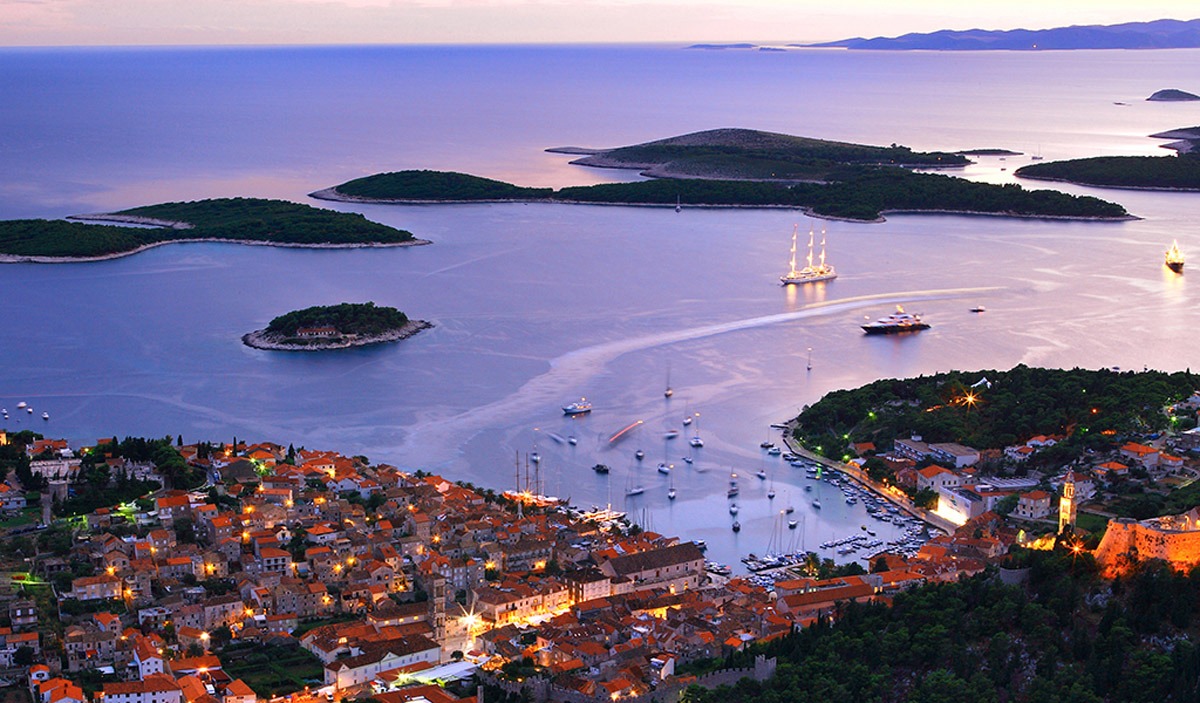 The lavender island that Conde Nast's signature travel magazine called "one of the “best 10 islands in the world”. A vacation on the lavender island of Hvar means extraordinary experiences every day - from visiting an ancient olive grove and learning about what Homer called “liquid gold”, taking a Jeep safari to discover hidden inland Hvar to exploring a castle, visiting the oldest theatre in Europe or tasting spectacular wine and local delicacies at an award-winning vineyard.
The gently rolling hills, spectacular beaches, lush vineyards, and vibrant nightlife of Hvar make it the perfect island getaway. Take a stroll down the medieval streets of this lovely island and you will encounter imposing fortifications that testify to the island’s ancient history.
Itinerary:
The lavender island that Conde Nast's signature travel magazine called "one of the “best 10 islands in the world”. A vacation on the lavender island of Hvar means extraordinary experiences every day - from visiting an ancient olive grove and learning about what Homer called “liquid gold”, taking a Jeep safari to discover hidden inland Hvar to exploring a castle, visiting the oldest theatre in Europe or tasting spectacular wine and local delicacies at an award-winning vineyard.
The gently rolling hills, spectacular beaches, lush vineyards, and vibrant nightlife of Hvar make it the perfect island getaway. Take a stroll down the medieval streets of this lovely island and you will encounter imposing fortifications that testify to the island’s ancient history.
Itinerary:
- Breakfast at the hotel and morning at leisure.
- Our wine tour begins in Hvar town with a drive to the other side of the island to the island’s most important wine region. Continuing further we’ll visit two of the most famous Croatian winemakers. The wine tour includes two wineries of our choice (depends on availability). Hvar wine tour - Private tour of the Hvar island accompanied by an official guide and a driver in a modern, air-conditioned car with a dinner in an olive grove Included: pick up, guide/driver, car transfer, 2 x wine tasting, dinner with wine
- Return to Hvar town for time at leisure and an overnight in Hvar
6
Day 6: HVAR - KORČULA
 Korčula was first mentioned as early as the 10th c. in works of Byzantine historians under the name “Stone Town”. It flourished under the Venetian government and later on it spread around the town walls. But in spite of all that, it is still the most famous as the birthplace of Marco Polo who was probably born here in 1254, and reminders of him can be seen all around the town, including the extremely interesting Marco Polo Museum which is something you definitively don`t want to miss when visiting this beautiful Dalmatian town. Today it`s a town where you can vividly feel the Mediterranean spirit of people who live and work in this mixture of Gothic, Renaissance, and Baroque architecture.
Itinerary:
Korčula was first mentioned as early as the 10th c. in works of Byzantine historians under the name “Stone Town”. It flourished under the Venetian government and later on it spread around the town walls. But in spite of all that, it is still the most famous as the birthplace of Marco Polo who was probably born here in 1254, and reminders of him can be seen all around the town, including the extremely interesting Marco Polo Museum which is something you definitively don`t want to miss when visiting this beautiful Dalmatian town. Today it`s a town where you can vividly feel the Mediterranean spirit of people who live and work in this mixture of Gothic, Renaissance, and Baroque architecture.
Itinerary:
- Breakfast at the hotel and check out.
- Assistance with your luggage and fast ferry tickets from Hvar to Korčula island
- Upon arrival hotel staff is waiting at the port with a hotel sign and provides assistance to the hotel.
- Check into your hotel and explore its facilities ( early check-in not guaranteed).
- Meet your local guide for a private walking tour of Old Town Korčula. Explore the town of Korcula with its long history, ingenious building strategies, peculiar building layout, and a legend of a great merchant traveler Marco Polo that was born and spent his childhood in the streets of Korcula.
- Enjoy your unique tailor-made dinner at a renowned LD restaurant (drinks to be paid for on the spot).
- Time at leisure and overnight in Korčula.
7
Day 7: KORČULA
Itinerary:
- Breakfast at the hotel and morning at leisure.
- Enjoy a fantastic evening out in the rural village of Zrnovo with a local family. First a small demonstration of how to shape the local pasta specialty "makaruni" before having a try for yourself. You'll then head out for a walk around the village with the charming father of the family. Passing vineyards, olive trees, and old stone houses, you will learn the history of this Korcula Island village and more about the lives of the people who live and work here. After your walk, you will return to their family restaurant for a delicious traditional dinner which will include a home-made pasta dish and local wine.
- Time at leisure and overnight in Korčula.
8
Day 8: KORČULA - DUBROVNIK
Peljesac is a peninsula in southern Croatia, in the Dubrovnik -Neretva County, just about an hour and a half drive from Dubrovnik. It is around 70 km long and is connected with the Croatian Mainland at Ston. The Peljesac Channel divides the peninsula from the island of Korcula. Scattered like breadcrumbs across the foothills of the dolomites, the hamlets and villages of southern Peljesac evoke an ancient past. The rocks, the vegetation, the groves of pine and cypress - everywhere a sense of timelessness prevails. On the hills above the sea, abandoned villas and gardens, stone walls, and columns lie crumbling in the sun. Lemon, fig, and almond trees, herbs, and wildflowers surround the village's gardens and fields. The historical sea captains' town of Orebic - with its shops, market, cafes, and restaurants is on the bottom of the Sveti Ilija Mountain. A footpath into the mountains to the summit of Sveti Ilija begins near Viganj too - Croatia's windsurfing capital. There, seaside restaurants and pebbly beaches attract a lively crowd in the summer months. The island of Korcula and Mljet are is just across the channel. Pelješac peninsula is known as one of the best wine-producing regions in Croatia.
 Ston is a small Mediterranean town situated on the Pelješac Peninsula, with a history that reaches back as far as the 14th century. It is a small town with the longest stone wall in Europe(5,5km), with narrow quiet streets, noble ancient houses, and traces of ancient cultures. Its former value as a “salt city” gets confirmed even today in the plants of the oldest active salt-works in the world. These saltworks have remained faithful to the tradition and to the natural way of salt production which has not changed since remote ages.
The town is best known for its oyster and mussel beds, and during your tour, you will not only participate in oyster harvesting but also be served fabulous versions of these shellfish along with traditional dish buzara for light lunch.
Pelješac peninsula is renowned for its spectacular coastline and historic towns and wine production. Enjoy the magnificent peninsula scenery and picturesque vineyards. You can start this tour with a visit to Ston, a town famous for its 5 km long defensive wall, the second largest in the world, right after the Chinese wall, and finish in Mali Ston, the center of oyster production in Croatia.
Ston is a small Mediterranean town situated on the Pelješac Peninsula, with a history that reaches back as far as the 14th century. It is a small town with the longest stone wall in Europe(5,5km), with narrow quiet streets, noble ancient houses, and traces of ancient cultures. Its former value as a “salt city” gets confirmed even today in the plants of the oldest active salt-works in the world. These saltworks have remained faithful to the tradition and to the natural way of salt production which has not changed since remote ages.
The town is best known for its oyster and mussel beds, and during your tour, you will not only participate in oyster harvesting but also be served fabulous versions of these shellfish along with traditional dish buzara for light lunch.
Pelješac peninsula is renowned for its spectacular coastline and historic towns and wine production. Enjoy the magnificent peninsula scenery and picturesque vineyards. You can start this tour with a visit to Ston, a town famous for its 5 km long defensive wall, the second largest in the world, right after the Chinese wall, and finish in Mali Ston, the center of oyster production in Croatia.
 Dubrovnik is a medieval city on the Croatian side of the Adriatic coastline and a treasure trove of cultural, historical monuments that were created throughout its thousand-year existence.
In the past, it was a City-Republic, and alongside Venice one of the most famous cultural-economic centers on the Mediterranean.
In more recent times, it has become the center of modern cultural and tourist events: a city of summer festivals – an international parade of top musical and theatrical achievements, a city of museums and galleries. These values have turned Dubrovnik into a place that offers a rich selection of various experiences and excitement, but also a complete holiday in a quiet and calming, mild Mediterranean ambiance, and wonderful seaside landscapes.
Itinerary:
Dubrovnik is a medieval city on the Croatian side of the Adriatic coastline and a treasure trove of cultural, historical monuments that were created throughout its thousand-year existence.
In the past, it was a City-Republic, and alongside Venice one of the most famous cultural-economic centers on the Mediterranean.
In more recent times, it has become the center of modern cultural and tourist events: a city of summer festivals – an international parade of top musical and theatrical achievements, a city of museums and galleries. These values have turned Dubrovnik into a place that offers a rich selection of various experiences and excitement, but also a complete holiday in a quiet and calming, mild Mediterranean ambiance, and wonderful seaside landscapes.
Itinerary:
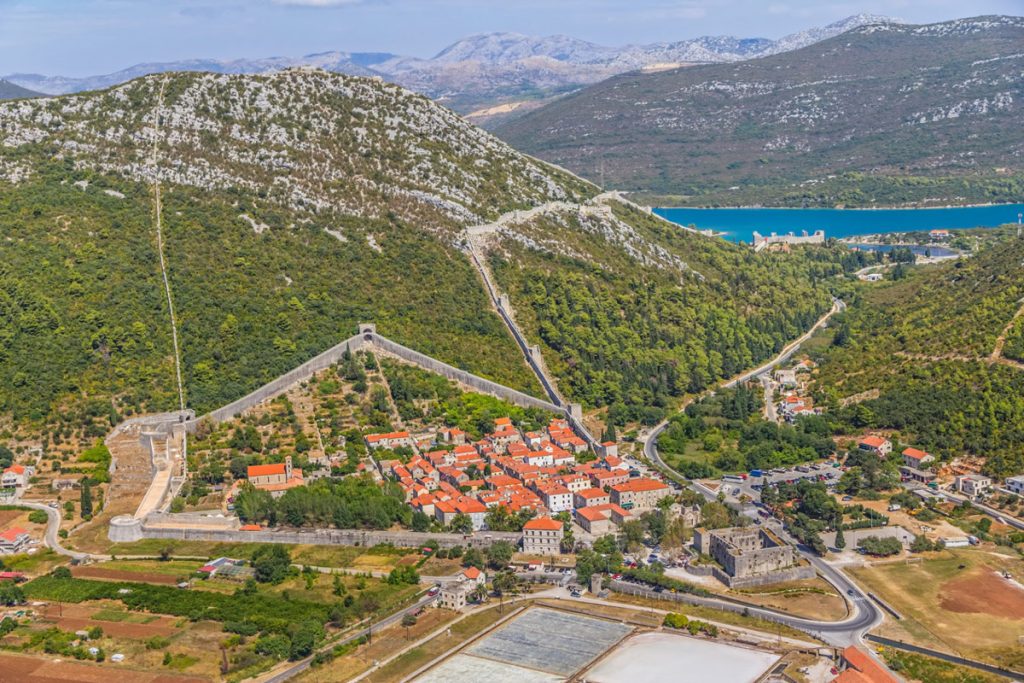 Ston is a small Mediterranean town situated on the Pelješac Peninsula, with a history that reaches back as far as the 14th century. It is a small town with the longest stone wall in Europe(5,5km), with narrow quiet streets, noble ancient houses, and traces of ancient cultures. Its former value as a “salt city” gets confirmed even today in the plants of the oldest active salt-works in the world. These saltworks have remained faithful to the tradition and to the natural way of salt production which has not changed since remote ages.
The town is best known for its oyster and mussel beds, and during your tour, you will not only participate in oyster harvesting but also be served fabulous versions of these shellfish along with traditional dish buzara for light lunch.
Pelješac peninsula is renowned for its spectacular coastline and historic towns and wine production. Enjoy the magnificent peninsula scenery and picturesque vineyards. You can start this tour with a visit to Ston, a town famous for its 5 km long defensive wall, the second largest in the world, right after the Chinese wall, and finish in Mali Ston, the center of oyster production in Croatia.
Ston is a small Mediterranean town situated on the Pelješac Peninsula, with a history that reaches back as far as the 14th century. It is a small town with the longest stone wall in Europe(5,5km), with narrow quiet streets, noble ancient houses, and traces of ancient cultures. Its former value as a “salt city” gets confirmed even today in the plants of the oldest active salt-works in the world. These saltworks have remained faithful to the tradition and to the natural way of salt production which has not changed since remote ages.
The town is best known for its oyster and mussel beds, and during your tour, you will not only participate in oyster harvesting but also be served fabulous versions of these shellfish along with traditional dish buzara for light lunch.
Pelješac peninsula is renowned for its spectacular coastline and historic towns and wine production. Enjoy the magnificent peninsula scenery and picturesque vineyards. You can start this tour with a visit to Ston, a town famous for its 5 km long defensive wall, the second largest in the world, right after the Chinese wall, and finish in Mali Ston, the center of oyster production in Croatia.
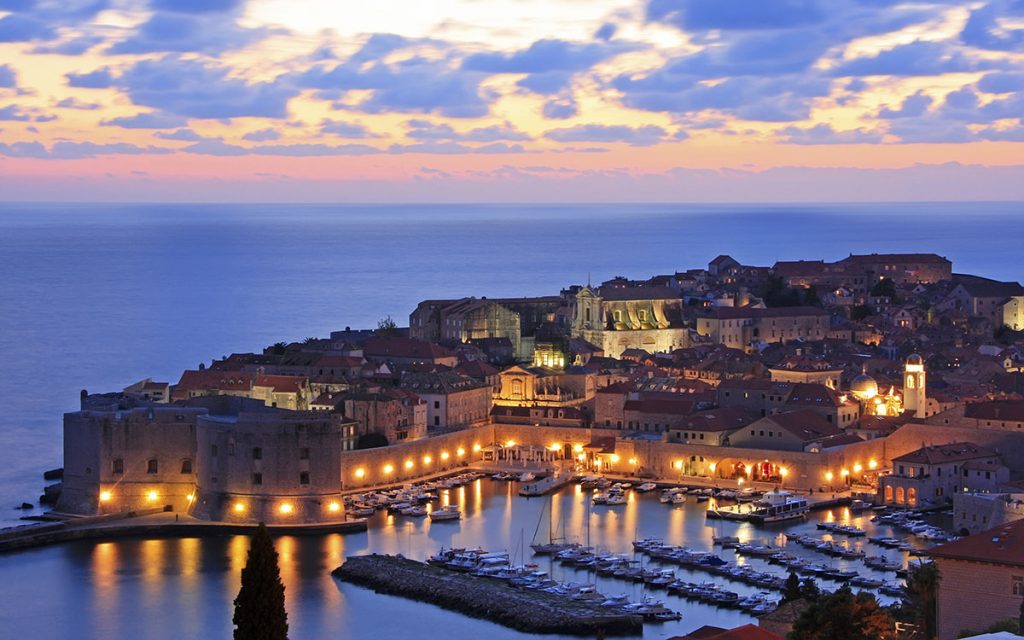 Dubrovnik is a medieval city on the Croatian side of the Adriatic coastline and a treasure trove of cultural, historical monuments that were created throughout its thousand-year existence.
In the past, it was a City-Republic, and alongside Venice one of the most famous cultural-economic centers on the Mediterranean.
In more recent times, it has become the center of modern cultural and tourist events: a city of summer festivals – an international parade of top musical and theatrical achievements, a city of museums and galleries. These values have turned Dubrovnik into a place that offers a rich selection of various experiences and excitement, but also a complete holiday in a quiet and calming, mild Mediterranean ambiance, and wonderful seaside landscapes.
Itinerary:
Dubrovnik is a medieval city on the Croatian side of the Adriatic coastline and a treasure trove of cultural, historical monuments that were created throughout its thousand-year existence.
In the past, it was a City-Republic, and alongside Venice one of the most famous cultural-economic centers on the Mediterranean.
In more recent times, it has become the center of modern cultural and tourist events: a city of summer festivals – an international parade of top musical and theatrical achievements, a city of museums and galleries. These values have turned Dubrovnik into a place that offers a rich selection of various experiences and excitement, but also a complete holiday in a quiet and calming, mild Mediterranean ambiance, and wonderful seaside landscapes.
Itinerary:
- Breakfast at the hotel and check-out
- Meet with your driver for a private transfer from Korčula to Dubrovnik with en-route stops on the Pelješac peninsula.
- On your drive to Dubrovnik stop to visit a local Vineyard/Estate.
- Enjoy your lunch in the traditional tavern/konoba, where you’ll be offered with various Dalmatian sea and meat specialties and local, organically grown vegetables which, in combination with the wines, create a unique gastro-enological experience.
- As the car heads further you will have a great opportunity to enjoy the picturesque hillside of Dalmatia’s magical interior: a unique blend of high mountains and small patches of fertile fields. It is part of the country that looks as if it was stopped in time.
- Onward drive to Dubrovnik, check into your hotel and time at leisure. Overnight in Dubrovnik.
9
Day 9: DUBROVNIK
 Stradun - the main street of Dubrovnik where everyone's walked and also the busiest street where you stroll over marble tiles. Stradun is a great place for everyone where all the shopping can be done, cafes and restaurants are in the streets and many wonderful shops.
Onofrio’s Fountain - this drinking fountain is located just at the beginning of Stradun, the main street of the old town. The structure was named after its builder, the Italian Onofrio de la Cava, which dates from 1440 and includes 16 sides. The concept is part of the water supply system of the city and brings water from the well in Rijeka Dubrovacka, more than 20 km away, to the heart of the city. Before that, this interest was, therefore, more than a masterpiece of architectural sophistication. Originally the fountain was decorated with a sculpture, which was destroyed in the earthquake of 1667, the Remaining 16 stone masks from which the water flows into a lake.
The Clock Tower was built in the 15th Century right at the other end of the Placa (the main thoroughfare) and represented alongside nearby buildings a free city-state. The tower is approximately 31 meters in height and built by Grubacevic, Utisenovic, and Radoncic, local masters. Following an earthquake, the structure of the Clock Tower lost its structure and leaned. In order for it not to fall the Clock Tower was rebuilt in 1929.
Orlando's column was built in 1418, then it was the focal point of the city and Government ordinances and punishment carried out. A flag flies above the statue with the 'Libertas' motto.
The medieval cult of Orlando (Roland) started here in the 12th century based upon the epic poem 'Song of Roland'
Itinerary:
Stradun - the main street of Dubrovnik where everyone's walked and also the busiest street where you stroll over marble tiles. Stradun is a great place for everyone where all the shopping can be done, cafes and restaurants are in the streets and many wonderful shops.
Onofrio’s Fountain - this drinking fountain is located just at the beginning of Stradun, the main street of the old town. The structure was named after its builder, the Italian Onofrio de la Cava, which dates from 1440 and includes 16 sides. The concept is part of the water supply system of the city and brings water from the well in Rijeka Dubrovacka, more than 20 km away, to the heart of the city. Before that, this interest was, therefore, more than a masterpiece of architectural sophistication. Originally the fountain was decorated with a sculpture, which was destroyed in the earthquake of 1667, the Remaining 16 stone masks from which the water flows into a lake.
The Clock Tower was built in the 15th Century right at the other end of the Placa (the main thoroughfare) and represented alongside nearby buildings a free city-state. The tower is approximately 31 meters in height and built by Grubacevic, Utisenovic, and Radoncic, local masters. Following an earthquake, the structure of the Clock Tower lost its structure and leaned. In order for it not to fall the Clock Tower was rebuilt in 1929.
Orlando's column was built in 1418, then it was the focal point of the city and Government ordinances and punishment carried out. A flag flies above the statue with the 'Libertas' motto.
The medieval cult of Orlando (Roland) started here in the 12th century based upon the epic poem 'Song of Roland'
Itinerary:
- Breakfast at the hotel
- Meeting with your guide for a private walking tour of Old Town Dubrovnik.
- Take in all the main sights and explore the architecture and history of this famous city. Accompanied by our experienced guide, the story of Dubrovnik's golden age will unfold before your eyes.
- The walking tour route takes you around the Old Town via Onofrio's Fountain and up Prijeko Street to the Old Port - the key to Dubrovnik's trading and maritime success. Along the way you will pay a visit to St. Saviour's, the grandiose Franciscan and Dominican church, and see wine-producing vines believed to be more than 100 years old.
- Time at leisure to explore the town further on your own
- OPTIONAL: Visit to the Dubrovnik City Walls - the city walls are considered to be one of the most grandiose fortification monuments in Europe. The first fortifications were built already in the 8th century, but the most intense construction took place from the mid-15th to the end of the 16th century. The huge earthquake in 1667 did not do much damage. The ramparts encompass the city in an irregularly shaped polygon, with Fort Minčeta at the highest northwestern landward corner of the city and with Fort St. Johns on the southeastern seaside.
- OPTIONAL: Take the Dubrovnik Cable Car and reach a unique viewpoint above the city (on your own) Glide through the air on a scenic adventure. The Cable Car ride offers breathtaking views of the Old Town of Dubrovnik, stunning coastal sights and magnificent sunsets. Once you reach the top, take your time and relax and enjoy the unique views of Dubrovnik and the Adriatic.
- Return to the hotel on your own, time at leisure and an overnight in Dubrovnik
10
Day 10: DUBROVNIK
Itinerary:
- Breakfast at the hotel and check out
- Private transfer from Dubrovnik to Dubrovnik Airport for a departure flight
SIGNATURE TOUR includes:
- ALL PRIVATE and ENGLISH SPEAKING GUIDES AND DRIVERS
- VAT TAX INCLUDED
- 24hr concierge and in Croatia assistance
- Private transfer from Split Airport to Split in a modern, air-conditioned vehicle
- 3 nights in a 4*hotel in Split, double/twin room, BB basis
- English speaking guide for private walking tours of Old Towns Split & Trogir (entrance fees not included)
- Private round trip transfer from Split to Trogir in a modern, air-conditioned vehicle
- Private round trip transfer from Split to Šibenik in a modern air-conditioned vehicle accompanied by an English speaking driver
- English speaking guide for a private walking tour of Šibenik (entrance fees not included)
- Tasting menu at Michelin award restaurant (drinks to be paid on spot)
- Assistance with your luggage and fast ferry tickets from Split to Hvar
- English speaking guide for a private walking tour of Hvar town (entrance fees not included)
- 2 nights in a 4* hotel in Hvar, double/twin room, sea view BB basis
- Hvar wine tour - Private tour of the Hvar island accompanied by an official guide and a driver in a modern, air-conditioned car with a dinner in an olive grove (Included: pick up, guide/driver, car transfer, 2 x wine tasting, dinner with wine)
- Fast ferry tickets from Hvar to Korčula
- English speaking guide for a private walking tour of Old Town Korčula (entrance fees not included)
- Unique tailor-made dinner experience at a renowned restaurant (drinks to be paid on spot)
- 2 nights in a 4* hotel in Korčula, double/twin room, BB basis
- Culinary Tour (Included: Transfer to/from Zrnovo from Korcula, Pasta demonstration & opportunity to shape traditional pasta, Guided walk around Zrnovo village, Minimum 2 course dinner with house wine)
- Private transfer from Korčula to Dubrovnik with an en-route stop in Ston in a modern air-conditioned vehicle (entrance fee to Ston Walls not included)
- Wine tasting with lunch at Vinyard/Estate
- 2 nights in a 4* hotel in Dubrovnik, double/twin room, sea view, BB basis
- One-way private transfer from your hotel to the Old Town in a modern, air-conditioned vehicle
- English speaking guide for a private walking tour of Old Town Dubrovnik (entrance fees not included)
- Private transfer from Dubrovnik to Dubrovnik Airport in a modern, air-conditioned vehicle
- Meals and drinks not mentioned above
- Airfare, Travel Insurance
- Additional excursions and/or services not mentioned in the program
- Personal expenses (internet, telephone, mini bar etc.)
- Tips and porterage services
- Available dates upon request
- Travel between late May - early October
- Double occupancy, Solo traveler with supplement
- Customizable! Make this your own, custom experience
- Price and availability are subject to change based on travel dates, availability, hotels



 English
English French
French
